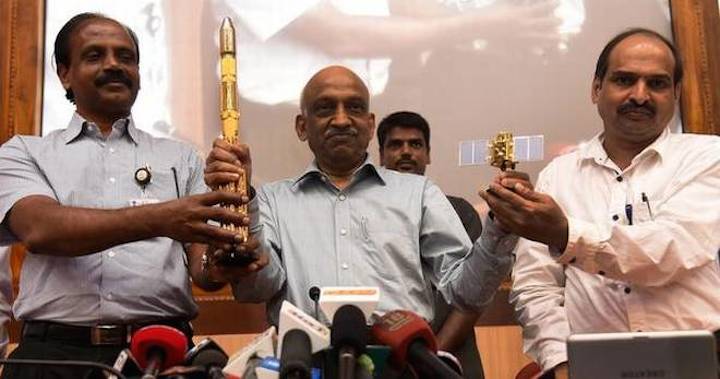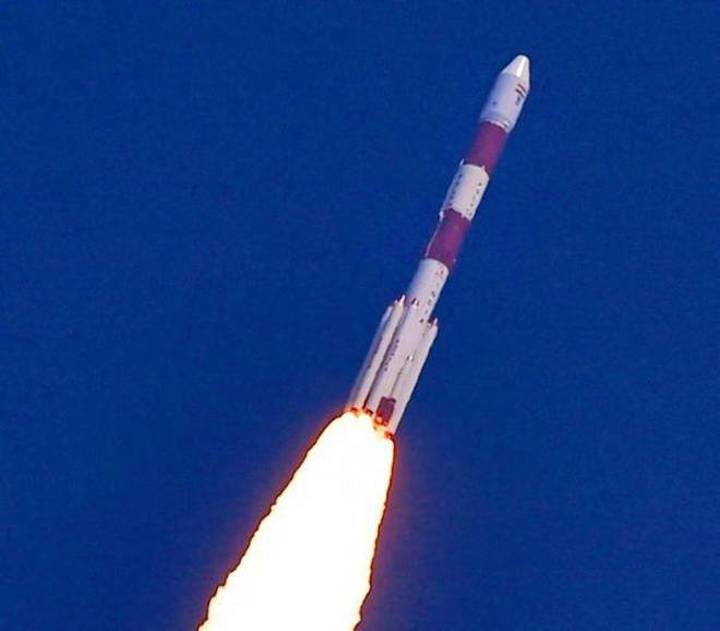17.12.2016
PSLV-C 37 scheduled for launch on January 27

PSLV project director B Jayakumar. | Photo Credit: V. Ganesan
The next PSLV-C37 that will put into orbit a record number of 83 satellites is being scheduled for launch on January 27, said PSLV project director B Jayakumar.
Sharing the dais with Vikram Sarabhai Space Centre director K Sivan who came here to receive the 100th nozzle for a PSLV rocket from city based Resins and Allied Productions Mr Jayakumar said that six PSLVs had been launched in 2016.
Mr Sivan said that ISRO was planning to launch 12 to 18 PSLVs in a year. He said the 100th nozzle that was custom-built by Vijayawada based industry Resins and Allied Products (RAP) would be used in the historic PSLV that would launch a record 83 satellites. He said there was demand from foreign countries to send their satellites on PSLV rockets because they were launched as per schedule and were reliable.
Quelle: The Hindu
-
Update: 19.01.2017
.
PSLV-C37 launch likely in February
The Satish Dhawan Space Centre (SDSC) in Sriharikota is making preparations for the launch of 103 satellites into space on board the Polar Satellite Launch Vehicle (PSLV-C37) most probably in the first week of February.
It is learnt that the Mission Readiness Review (MRR) meeting held at SHAR has agreed upon taking up the mission as per the plan.
The integration of the launch vehicle on the first launch pad at SHAR is progressing, even as scientists are awaiting the arrival of the satellites for speeding up the arrangements for the final launch.
Among the 103 satellites, 100 are from the Netherlands, Switzerland, and the US put together. The remaining are two nano satellites belonging to the Indian Space Research Organisation (Isro) and one Cartosat-2 series indigenous satellite. Once this launch is completed, India will occupy the top place among the countries that have sent the highest number of satellites into orbit.
Quelle: The Hindu
-
Update: 22.01.2017
.
How ISRO plans to launch 103 satellites on a single rocket

BLAST-OFF:In this photo dated December 7, 2016, PSLV C36 lifts off from the space centre in Sriharikota.— Photo: PTI
The mission will break Russia’s record of sending 37 satellites at one go
The Indian Space Research Organisation (ISRO) will set a record when it launches 103 satellites in one go on a single rocket in the first week of February.
Explaining how all the satellites will be placed in orbit, Dr. K. Sivan, Director of the Vikram Sarabhai Space Centre (VSSC), Thiruvananthapuram, said: “The satellites will be separated from the launch vehicle in different directions. The separation angle and time of separation will be such that one satellite will not collide with another.”
The satellite separated from the launch vehicle will have a relative velocity of one metre per second. So after 1,000 seconds the distance between a satellite and the rocket will be 1,000 metres. “The satellite that gets launched first will move at a relatively faster velocity than the next satellite that is launched. Due to different relative velocities, the distance between the satellites will increases continuously but the orbit will be the same,” he said.
“When the vehicle reaches the orbital condition, we will wait for the disturbances to die down before the preparation for separation begins,” Dr. Sivan explained. At an orbital altitude of around 500 km, it would take the vehicle 90 minutes to complete one orbit. “So we have sufficient time to launch all the 103 satellites,” he added.
Even one degree difference in separation angle combined with relative velocity will ensure that no two satellites would collide. “The satellites will be injected into orbit at different locations at different angles, at different times and different orientations,” Dr. Sivan said.
In June last year, ISRO launched 20 satellites in one go. It took about 26 minutes to launch all the 20 satellites. In 2008, ISRO launched 10 satellites in a single mission. The highest number of satellites launched in a single mission so far has been 37 by Russia in 2014; NASA launched 29 satellites in one go in 2013.
ISRO’s workhorse PSLV (C37) with 103 satellites will be launched from the Satish Dhawan Space Centre in Sriharikota in Andhra Pradesh. With the exception of three satellites from India, the rest are from other countries.
Quelle: The Hindu
